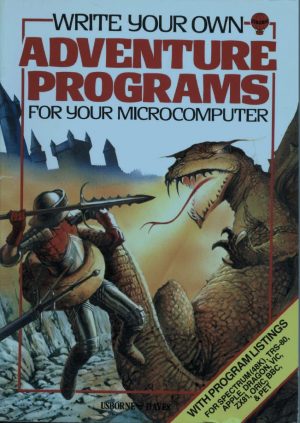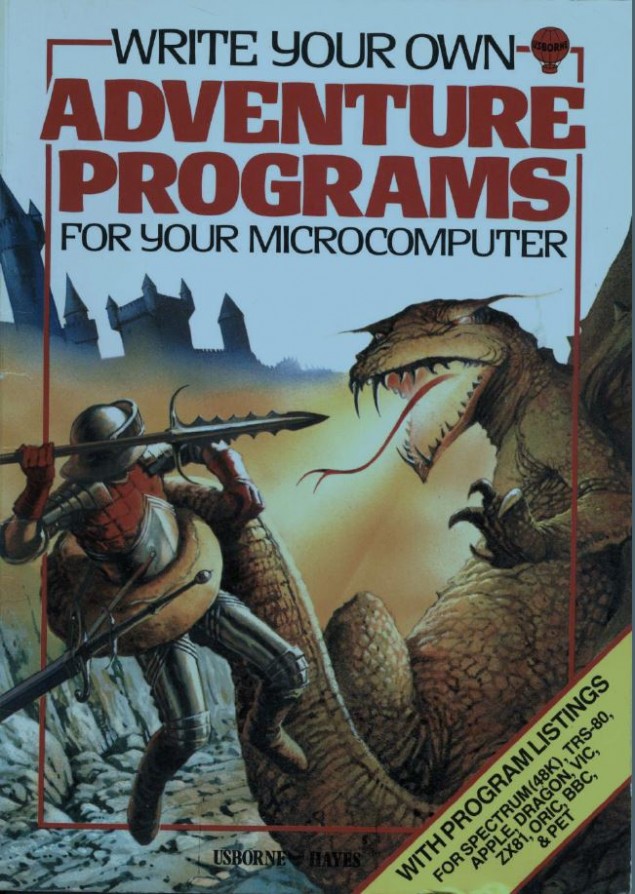
You may have written one …
The pleasures of the text
Frustrated gamers playing text adventures would inevitably find themselves at some time typing a string of expletives into the hapless interface only to be rewarded by a snide comment or just more stonewalling from the game. Infuriating and often very punitive on the player the punishing nature of these games made the actual mastery of a text adventure a special pleasure. No amount of button mashing or sly practice was going to make you look good in front of your friends when playing a text adventure. You needed to understand the constraints of the language system and the logic of the gameworld, or at least understand it well enough to get the job done. You had to figure out how to communicate effectively with the game, finessing a vocabulary of acts that would allow you to solve the challenges that you faced.
Navigating worlds of words
Navigating these worlds of words was a particular challenge, and having more than one person play was a good idea so someone could map the spaces as you moved through them. Learning the logic of moving through the gameworld was often a trial and error business. Patience and repetition (repetition insured by the inevitable death or failure) allowed you to plot a representation of the world. The descriptions of places were often engagingly evocative or playfully rewarded the player with puns and in-jokes. Grotnik Software’s “Bunyip Adventure”(1984) offers a compendium of Australiana from the farmers in the pub complaining about the “bloody drought, bloody rabbits, bloody flies…” to camping with a jolly swagman by a billabong under a coolibah tree on your way to solving the riddle of the bunyip. Nick Montfort in his work on interactive fiction suggest that exploration is itself a form of reading pleasure, an idea that Henry Jenkins has also discussed in relation to how narratives of travel work as story in videogames.
Making worlds
Playing text adventures on the micro computer evoked in some a desire not just to explore these worlds but create them too. Listings for text adventure games populated computer magazines of the early 1980s such as “PC Games: Australia’s Guide to Micro Entertainment” which boasted Australia’s largest Program Listing Section. Melbourne House included an uncredited type-in “Adventure” game in their 1982 book “Over the Spectrum” which was also available on a compilation cassette. There were specialist books dedicated to the writing of text adventures including Melbourne House published “The Computer & Video games Book of Adventure” by C&VG columnist Keith Campbell giving useful advice on how to write an adventure game. Jenny Tyler and Les Howarth’s popular book “Write your own Text Adventure for your Microcomputer”(1982, published by UK publishers Usborne) was a guide to writing a two word command text adventure in BASIC. It featured a full listing for a game “Haunted House” that players could then alter but also guides to building your own maps and creating puzzles for those who wanted to start afresh with their own ideas. Aimed at a youthful audience they explained how text adventures worked as interactive databases and offered tips for debugging as a well as working with differing systems such as the Vic20, Spectrum, BBC Micro Dragon and Oric in particular being aware of how much memory your computer had to work with.
Australian designer Matthew Hall was in still in primary school when he began writing text adventures for his Commodore 64 armed with a copy of “Creating Adventures on your Commodore 64”(1984) a gift from his grandfather.
You can download some of his original text adventure games here
The Matt Hall C64 Bundle! 30 years in the making!
Did you write text adventures in the 1980s?
Please share with us your memories of making text adventures. What were your influences? Who played your games?




My first text adventure I ever played was “Espionage Island” from Sinclair Research (written by Artic Computing) for the 48k ZX Spectrum. I also had the Melbourne House release of “The Hobbit”, but that I didn’t play anywhere as much as the previous one. Espionage island was pure text. As a kid, reading was a big thing (those classic Enid Blyton books like Secret Seven, Famous Five) and that would often fire the imagination in terms of visualising the story.
For me, Espionage island was just that – it was easy to imagine some kind of visual by the text. The Hobbit came along with its graphics, and I think in a way this whole “being shown” meant less imagine was used. Its possibly why I didn’t play it often – and of course drawing the images was slow… I’d probably start to lose interest while waiting (I don’t think I was an overly patient kid – probably less then I am now. 😀 )
And Yes. Like a few kids, I indeed did write my own adventure game after being inspired by the others I’d play from bought tapes. It was a 10 location “graphical” sci-fi adventure. Back then, it wasn’t like I could just pull up a bitmap and display it. The graphics were still drawn out using plots, draws, and other screen drawing functions. This makes things take a little time before you could start entering commands, but unlike the Hobbit mine were more line-art and no solid colour fills (which is where things would just slow down)
Obviously the amount of code meant some locations didn’t have an image. Plus it took a lot of time to type in lines and lines of code to draw the images…
It was on a planet – you’d crash landed and you had to make it to a moon base and get to an escape pod to finish. To get to the moon base, you’d have to do things like get various survival clothing before exiting the ship. You’d have to wander around a crater, blocked at the half way point by a large rock…
When the player reached a location, you could determine the outcome by just querying if something had been done. If not, the player had to go back through the locations, or they died, failed, etc. As mentioned in the article above, the other challenge to adventures was also what to type. You’d kinda get stuck trying to guess what to do – do I “jump rock”, “climb over rock”, “push rock”? Sometimes a “look at rock” would reveal a clue (which would usually indicate that you should always type “Look” whenever you reached a location first before trying anything else).
In general, games like this were fairly easy to write. I think this game was a little clunkier code-wise then it should have been. Most the time you could drive an adventure through using just a collection of array variables to store and query data in the game. In this one, most of the game was coded as subroutines (one per location (from memory – but that’s a little fuzzy these days)). Keeping tabs on flags (ie. what tasks had been completed) was definitely a case of storing things in an array though.
The code was very primitive, and by todays standards not the most efficient or cleanest code… But hey, young kids and self-taught programming techniques – you couldn’t really blame anybody for that. 🙂
The first computer game I ever played was the adventure game Pyramid 2000 on the TRS-80. I never solved it — I was always one treasure short!
Later I learnt BASIC and wrote many of my own games on that machine. Nothing that anyone but I would play but I had a lot of fun inventing silly puzzles.
Oh look, you can play the original game online!
http://www.figmentfly.com/pyramid2000/pyramid.html
Maybe I should go back and see if I can find that last treasure.
Melbourne House published “Learning with Adventure Programs” in 1985. Written by Rosetta McLeod an English teacher who had used “The Hobbit” in class. She used the game to inspire underachieving students and was delighted by their engagement in the game and the interest it inspired in reading the book. “Learning with Adventure Programs” examined the text adventures “The Hobbit”, “Valhalla” and “Snowball”. It featured exercises on writing your own games and included work by McLeod’s students. The book is reviewed in the Australian magazine “Personal Computer Games” April 1985.
Greetings
The first text based adventure game I played was of course
“Adventure” on the mainframe computer at the South Australian
Institute of Technology . If I remember correctly a Control Data
Computer mainframe CDC73 . The systems programmer programmed
it to give you 30 steps . If you wanted to go further you paid him
a $1 and you were able to have unlimited steps . I never finished the game because I got stuck in the maze of small twisty passages going in all directions . In one cave I entered there was a bear .I entered “get bear” and the bear was added to my treasure . A short time later I encountered a troll guarding a bridge . The troll demanded some treasure . I entered “throw bear to troll” . The troll got the treasure and scurried away with the bear . I was then able to cross the bridge
Greetings
My first real computer was an Atari ST 520 which I bought when a friend at work told me about it . I could not afford a Macintosh and the Amiga was not available then . I played several Infocom text adventure games .
They were A Mind Forever Voyaging , Wishbringer , Leather Godess of Phobos and Hitch Hikers Guide to the Galaxy . The only one I finished was A Mind Forever Voyaging but I did not win the game . The first game I played on the Atari was called Hacker . Although not strictly a text adventure game as it had graphic pictures . The idea was to complete the picture puzzle from small pictures that had to be found .
Does anyone know if there are updated versions of the Micro Adventure series? I have fond memories of learning to program with those books and was hoping there was something similar now for my kids.